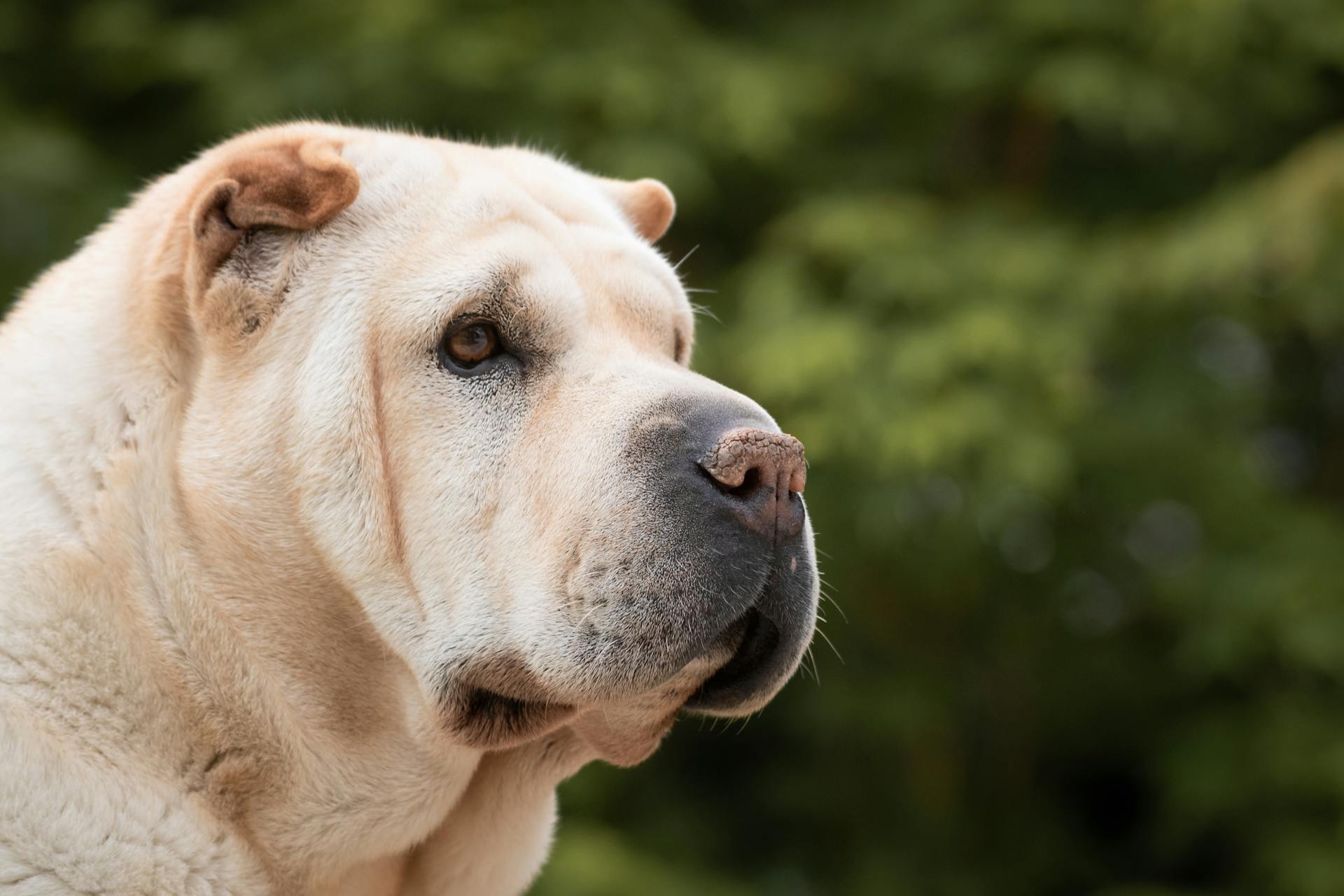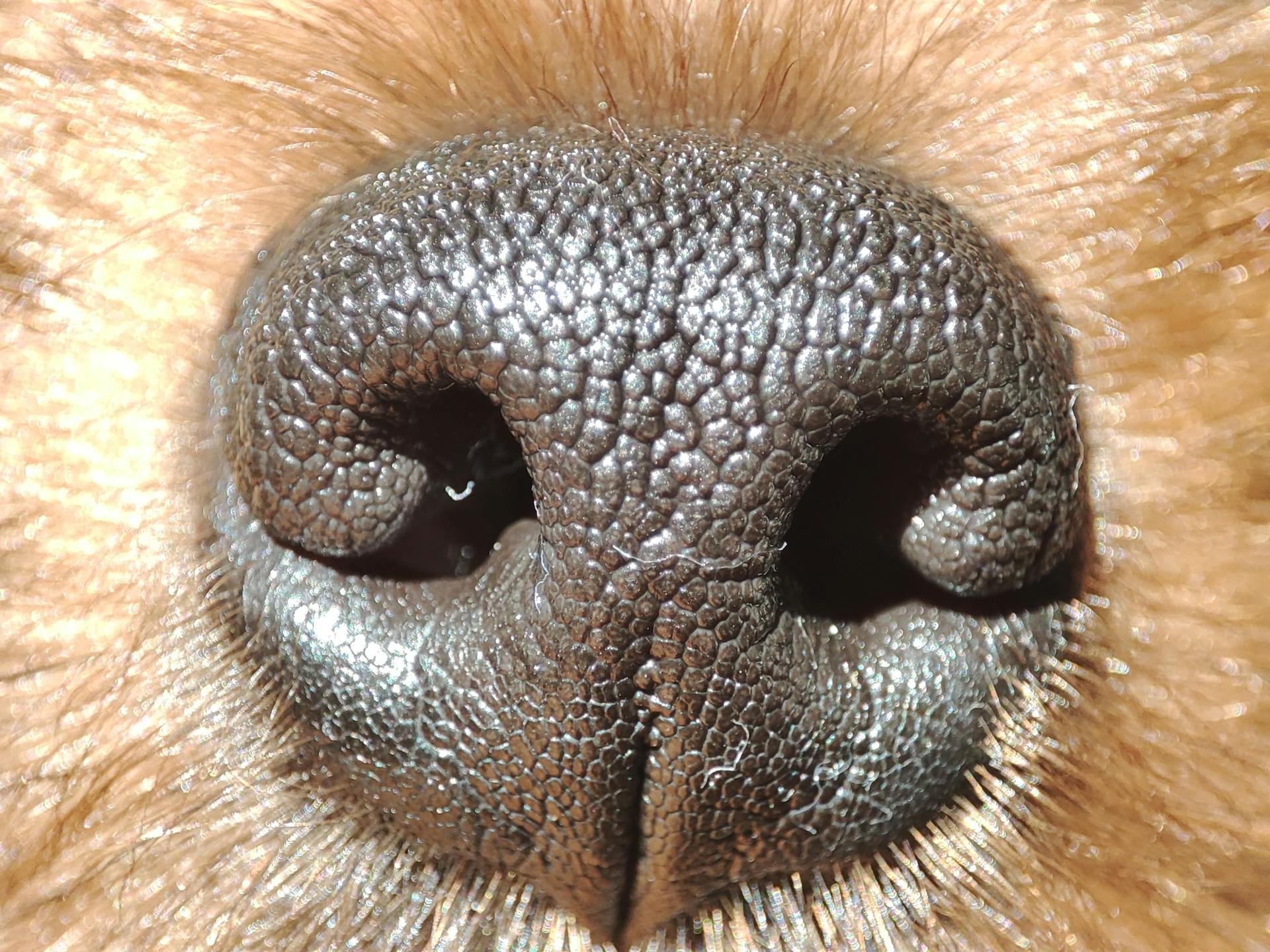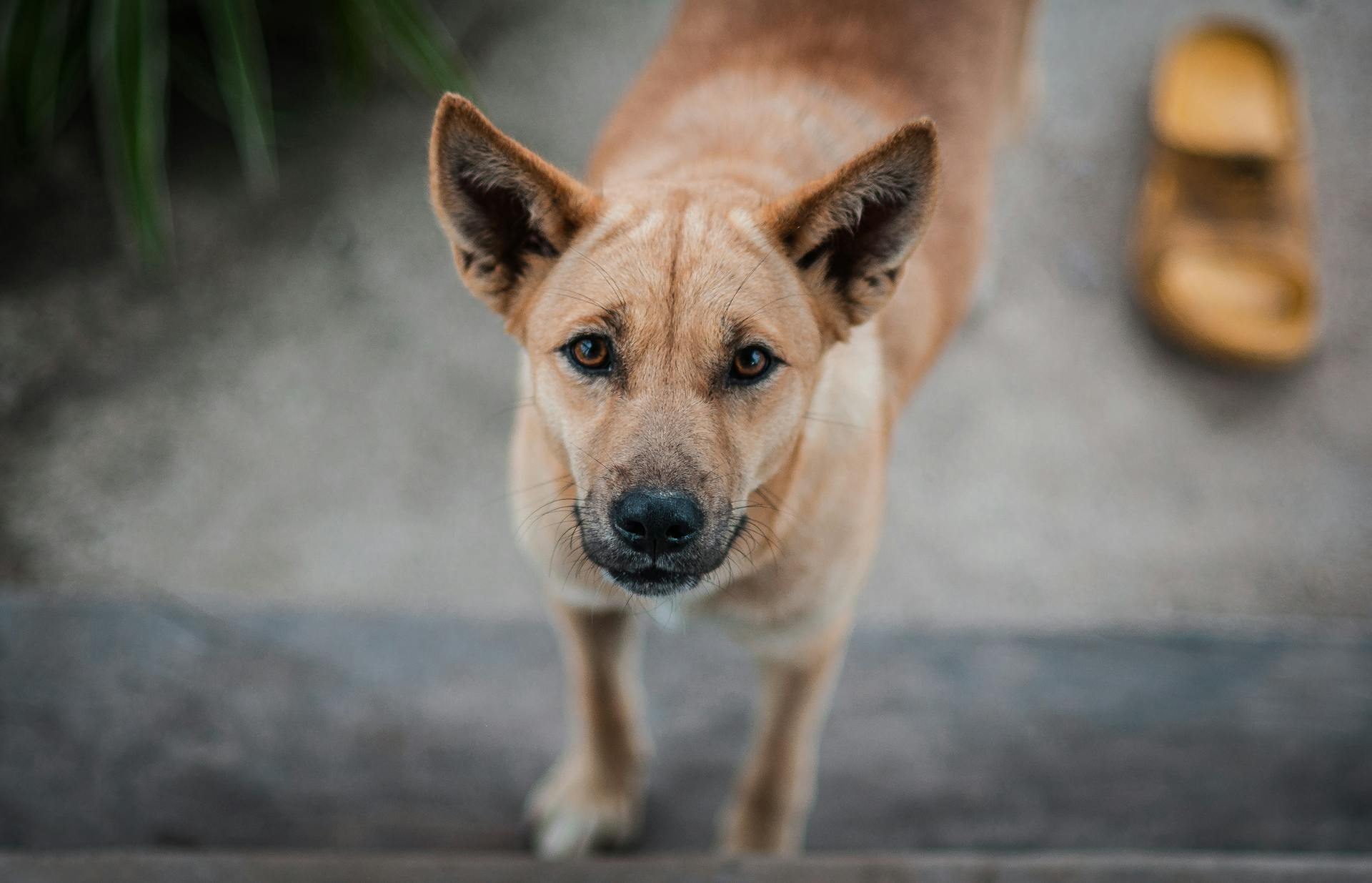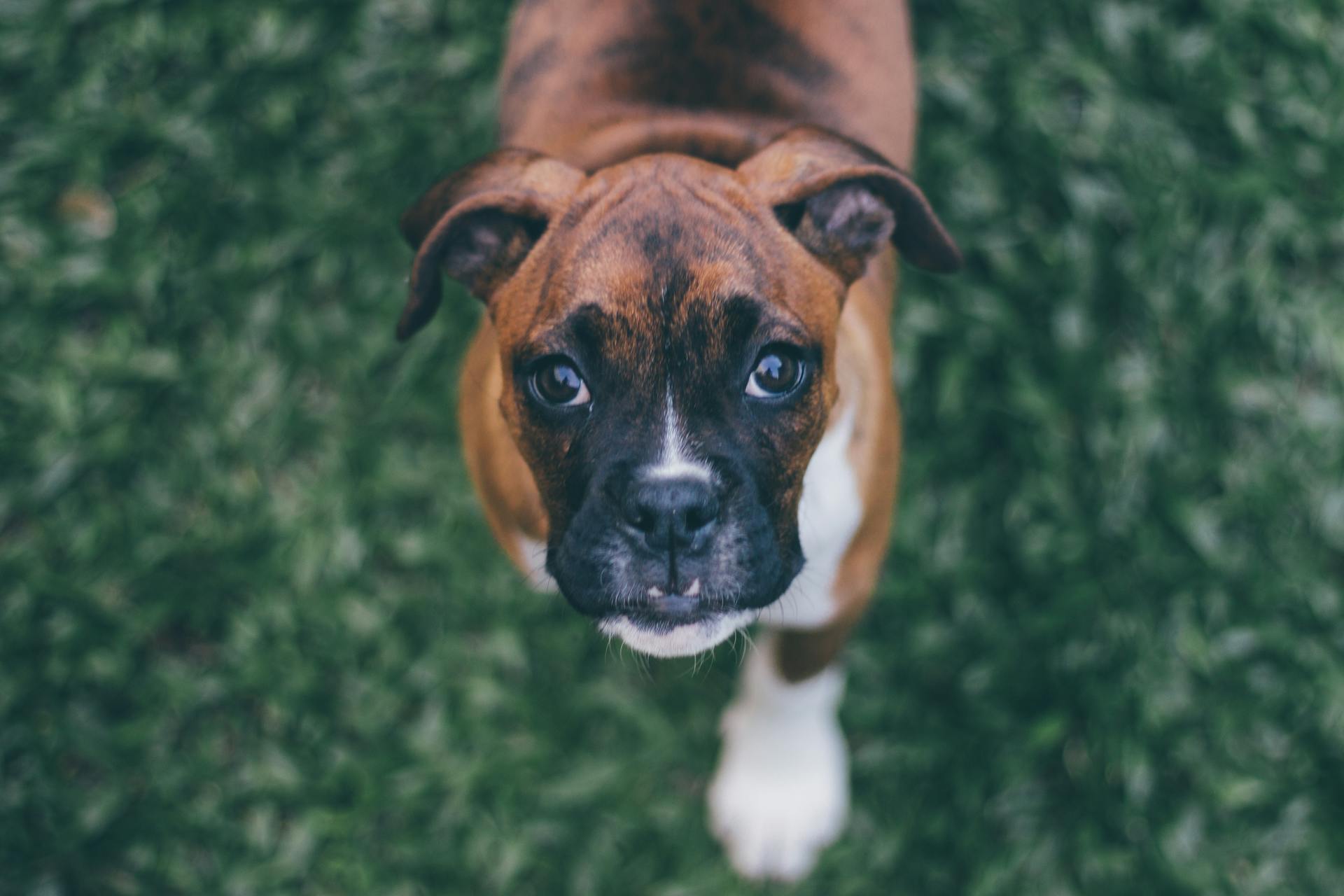
Hives in Boxer Dogs can be a real concern for owners, but understanding the causes and symptoms can help you take action to alleviate your dog's discomfort.
Boxer dogs are prone to hives due to their skin's unique characteristics, which can make them more susceptible to allergic reactions.
Hives can appear anywhere on the body, but they often appear on the face, ears, and paws of Boxer dogs.
In some cases, hives can be caused by environmental factors such as pollen, dust mites, or insect bites.
Consider reading: Dog Hives Allergic Reaction Staffy Skin Bumps
What Are Hives in Boxer Dogs?
Hives in Boxer dogs are caused by an allergic reaction to something in their environment, such as food, pollen, or insect bites.
Boxers are prone to developing hives due to their sensitive skin and genetic predisposition to allergies.
Hives can appear anywhere on a Boxer's body, but they often show up on their face, ears, and paws.
Symptoms of hives in Boxers can include red, itchy, and swollen patches on the skin.
In severe cases, Boxers may also experience difficulty breathing, rapid heartbeat, and a drop in blood pressure.
If you suspect your Boxer has hives, it's essential to consult with a veterinarian to determine the underlying cause and develop a treatment plan.
Related reading: Types of Dog Skin Diseases with Pictures
Causes and Triggers
Hives in Boxer dogs can be caused by a wide variety of allergens and triggers.
Common causes of hives in dogs include insect bites and stings, food allergies, and adverse reactions to medications.
Insect bites and stings are a common cause of hives in dogs, and can be caused by a single bite or sting, or by ingesting an insect.
Food allergies are another common cause of hives in dogs, and can be triggered by a variety of foods, including beef, dairy, and wheat.
Adverse reactions to medications can also cause hives in dogs, and can be triggered by a wide range of medications, including antibiotics and chemotherapy.
Other potential causes of hives in Boxer dogs include environmental allergens, such as pollen and dust, and contact allergens, such as soaps and shampoos.
Here are some common allergens that can cause hives in dogs:
- Insect bites and stings
- Food allergies
- Adverse reactions to medications
- Environmental allergens (pollen, dust, etc.)
- Contact allergens (soaps, shampoos, etc.)
It's worth noting that some causes of hives in dogs are not related to allergens at all, but rather to other factors such as heat, exercise, stress, and genetic abnormalities.
Heat and exercise can cause hives in dogs, especially in hot weather or during intense physical activity.
Stress can also cause hives in dogs, and can be triggered by a variety of factors, including changes in environment or routine.
Genetic abnormalities can also contribute to hives in dogs, and may be more common in certain breeds, such as the Boxer.
If this caught your attention, see: Dog Diseases That Cause Hair Loss
Symptoms and Signs
Hives in Boxer Dogs can manifest in a variety of ways, but the most common symptoms include raised wheals, which are small, round bumps on the skin, typically between one to five centimeters in diameter.
Itchiness is another telltale sign, as Boxer dogs will often scratch or bite the affected area. Red patches and swelling are also common, and may be accompanied by a bumpy or patchy-looking coat.
The symptoms of hives in Boxer dogs can vary, but often include:
- Raised wheals
- Itchiness
- Swelling
- Redness
- A “bumpy” or patchy-looking coat
In some cases, hives can also cause angioedema, which is a swelling that occurs below the surface of the skin, or atopy, a chronic allergic reaction characterized by inflamed and itchy skin.
Intriguing read: Doberman Pinscher Skin Bumps
What Do I Look Like?

If you notice your dog has hives, you might see raised bumps on their skin. These bumps, also known as wheals, are usually about the size of a nickel.
Hives can appear anywhere on the body, including the face, tongue, neck, legs, chest, abdomen, or back. They can affect just one area of the body or the entire body.
The bumps are often red in color, but you may not notice redness if they're on a very furry part of your dog. In this case, their hives may only look like fur-covered bumps.
Your dog will likely be trying to scratch, lick, or bite the areas affected as it will be itchy. This itchiness can be a giveaway that your dog has hives.
Here's a quick rundown of what to look out for:
- Raised bumps on the skin, usually about the size of a nickel
- Red bumps, but may be difficult to see on furry areas
- Bumps can appear anywhere on the body
- Itchiness, leading to scratching, licking, or biting
Keep in mind that hives can happen very fast – within minutes after exposure to whatever caused them.
Signs & Symptoms

Hives in dogs can appear anywhere on the body, including the face, tongue, neck, legs, chest, abdomen, or back. They can affect just one area of the body or the entire body.
The most common signs of hives in dogs include raised wheals, itchiness, swelling, redness, and a "bumpy" or patchy-looking coat. You may also notice your dog scratching, rubbing, or scooting on the ground due to discomfort.
Dog hives can appear suddenly, within minutes after exposure to an allergen, and can be accompanied by itchiness. The bumps, or wheals, are often red in color, but may not be visible on very furry parts of the body.
Some dogs may experience facial swelling, including around the eyes, and drooling due to discomfort in the mouth. In severe cases, hives can lead to anaphylaxis, a life-threatening emergency that requires urgent veterinary intervention.
Here are the common signs and symptoms of hives in dogs:
- Raised wheals
- Itchiness
- Swelling
- Redness
- A "bumpy" or patchy-looking coat
- Facial swelling
- Drooling
Diagnosis and Detection
Hives in boxer dogs can be diagnosed visually, but determining the underlying cause requires a comprehensive approach.
Your veterinarian will likely request a biochemistry profile and a complete blood count to look for signs of an allergic reaction, such as eosinophils.
A physical examination will also be conducted to check for other symptoms and signs of allergic reactions.
Your veterinarian will ask for a history of your dog's diet, changes in medications, and any relevant recent activities.
They may recommend pursuing several different courses of action depending on these findings.
In some cases, allergy testing may be necessary, especially in cases of chronic urticaria.
If food allergies are suspected, an elimination diet may be suggested to determine the cause.
Your veterinarian may also take skin scrapings for microscopic examination to look for issues like disease, mites, or yeast infections.
A skin scraping can provide valuable information about the underlying cause of the hives.
Intriguing read: What Do Boxer Dogs Look like
Blood tests may be indicative of markers related to urticaria, and a description of your dog's diet, grooming aids, and exposure to plants that could be skin irritants will be helpful.
If your veterinarian is having trouble diagnosing your dog's hives or the reason for their hives, they may perform additional diagnostics, such as blood work, skin cytology, skin scrapings, or fecal analysis.
Treatment and Management
Treatment for hives in Boxer dogs can be simple or more extensive, depending on the cause, severity, and duration of the allergic reaction. Antihistamines like Benadryl or Zyrtec are often the first line of defense when it comes to treating allergic reactions.
For mild cases, antihistamines like diphenhydramine can provide quick relief from swelling and itchiness. Corticosteroids may be required for severe or chronic episodes.
To prevent hives from reoccurring, it's essential to understand what caused them in the first place so that you can avoid the allergen in the future. If there is no apparent cause for your dog's hives, it may be more challenging to understand how to prevent hives in the future.
Here's an interesting read: Homemade Dog Treats for Allergic Dogs
Some common allergens that can cause hives in Boxer dogs include environmental and dietary allergies. These may require further diagnostics and treatment.
Here are some at-home remedies that may help relieve the allergic reaction:
- Administering Benadryl by mouth, as prescribed by your veterinarian, can help relieve symptoms.
- Bathing with a gentle oatmeal-based dog shampoo can help your dog feel more comfortable.
- Applying a cold compress to the hives or the most severely affected areas of your dog's skin can also provide relief.
In severe cases, if there's swelling in the mouth or airways, your dog will need medical intervention to be able to breathe. But, providing the correct treatment is followed and administered, recovery should be complete in a short period of time – a few days.
If your dog suffers from another outbreak of hives or a rash, keeping Benadryl in the household can help provide a swift form of treatment – especially if the allergen remains unidentified. Removing common allergens or pesticides from the home is also advised.
A fresh viewpoint: Dog Hives Pitbull Treatment
Recovery and Prevention
Recovery from hives in Boxer dogs is typically great, and with the right treatment, the prognosis is usually excellent. In severe cases, medical intervention may be necessary to ensure the dog can breathe.
Hives in Boxer dogs can be caused by allergies, sensitive skin, or other factors. Understanding the cause can take time, but by observing your dog, you may be able to determine some of the triggers.
To prevent hives in Boxer dogs, it's essential to identify and avoid allergens, such as grass, sun, or certain substances. Your veterinarian can help you determine the best protocols to prevent recurrent hives.
Here are some common allergens to be aware of:
- Grass
- Sun
- Certain substances
- Insect bites
If your Boxer dog has a food allergy, eliminating the offending food from their diet can be a simple solution. Common food allergens in dogs include chicken, wheat, and beef.
Recovery
Recovery from hives in dogs is usually great, with most cases resolving on their own after a few hours.
Some dogs may experience aggressive allergic reactions that require immediate medical attention, including a prescription for an EpiPen.
If your dog has had a moderate to severe allergic reaction, it's essential to follow up with a trip to the emergency room, even if they appear fully recovered.

Epinephrine is a short-acting drug, and without proper medical treatment, the allergic reaction may resume.
In most cases, hives resolve on their own after a few hours, but understanding the cause of the hives can take longer.
Learning how to manage your dog's sensitivities will help reduce the risk of recurrence, and observing your dog can help you deduce some of the triggers for their condition.
Dogs with grass allergies or sun sensitivities may need to wear protective clothing while outdoors to prevent future reactions.
Providing the correct treatment is followed and administered, recovery from hives should be complete in a short period of time – a few days.
In severe cases, if there's swelling in the mouth or airways, the dog will need medical intervention to be able to breathe.
To prevent urticaria in dogs from occurring in the first place, you can try an elimination diet to determine the allergen.
Most dogs see dramatic improvement after eliminating chicken from their diet due to some processing methods of chicken in dog food.
Adding fish oil to your dog's diet can also help soothe and restore their skin, regardless of the allergen.
Here's an interesting read: How Much Exercise Do Boxer Dogs Need
Preventing in
Preventing hives in dogs is a top priority for any pet owner. If your dog has a sensitivity or allergy to certain environments, substances, or medications, avoiding these triggers can help prevent hives.

Talk to your veterinarian about the best way to prevent recurrent hives in your dog. They will advise you on the best protocols to take to avoid further reactions.
There is no vaccine for hives, but in some cases, vaccines can trigger an immune response that causes hives. Always contact your veterinarian if your dog has a reaction to a treatment, medication, or vaccine.
Your veterinarian can help you understand the risks of severe allergic reactions, like anaphylactic shock. They will also help you identify the allergen responsible for your dog's hives and provide guidance on how to prevent future episodes.
To help sooth your dog's skin as the hives resolve, give them a nice oatmeal shampoo bath for some much-needed relief. Supplements containing omega 3 fatty acids can also provide relief for pruritus (itchy skin).
Here are some steps you can take to prevent hives in your dog:
- Avoid triggers that can cause hives
- Give your dog an oatmeal shampoo bath to soothe their skin
- Consider supplements containing omega 3 fatty acids to help with pruritus
- Work with your veterinarian to identify and avoid allergens
- Consider pre-treating your dog with an antihistamine injection prior to vaccination if a vaccine reaction is a concern
By following these steps and working closely with your veterinarian, you can help prevent hives in your dog and keep them healthy and happy.
Featured Images: pexels.com


